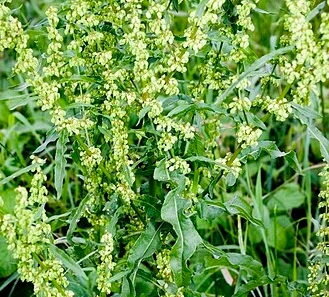Rumex crispus is a homeopathic medicine derived from the plant known as yellow dock or curly dock. It is primarily used to treat various respirat

Rumex crispus is a homeopathic medicine derived from the plant known as yellow dock or curly dock. It is primarily used to treat various respiratory and skin conditions.
Properties and Preparation:
Scientific Name: Rumex crispus
Common Name: Yellow dock, Curly dock
Preparation: The root of the Rumex crispus plant is used to prepare the homeopathic remedy.
Symptoms treatment and materia medica:
This condition is characterized by varied and numerous pains that are neither fixed nor constant. The cough is triggered by incessant tickling in the throat-pit, which extends down to the bifurcation of the bronchial tubes. Simply touching the throat-pit can provoke the cough. Exposure to even the slightest cold air exacerbates the symptoms, causing relief only when the body and head are completely covered with bedclothes. Rumex reduces the secretions of the mucous membranes while simultaneously increasing the sensitivity of the mucous membranes in the larynx and trachea. It also significantly affects the skin, causing intense itching, and leads to enlarged lymphatics and altered secretions.
Stomach: The stomach experiences several issues, including soreness at the edges of the tongue and a coated tongue. There is a sensation of a hard substance in the pit of the stomach, accompanied by hiccoughs, pyrosis, and nausea. Meat consumption leads to eructations and pruritus. Jaundice can develop after excessive alcohol use. Chronic gastritis presents with aching pain in the pit of the stomach and shooting pain in the chest, extending towards the throat-pit and worsening with any motion or talking. After meals, there is pain in the left breast and flatulence.
Respiratory: symptoms include a dry nose and a tickling sensation in the throat-pit that triggers a cough. There is a copious mucous discharge from the nose and trachea, and a dry, persistent cough that prevents sleep. The condition is aggravated by pressure, talking, and especially by inhaling cool air and at night. The expectoration is thin, watery, and frothy initially, becoming stringy and tough later. There is a rawness in the larynx and trachea, and soreness behind the sternum, particularly on the left side and in the region of the left shoulder. Additionally, there is a raw pain under the clavicle and a sensation of a lump in the throat.
Cough: Dry, incessant cough with tickling sensation in the throat, worse at night.
Sore Throat: Soreness and rawness in the throat, aggravated by cold air or breathing.
Hoarseness: Hoarse voice with a constant need to clear the throat.
Asthma: Wheezing, shortness of breath, and difficulty in breathing.
Skin: experiences intense itching, particularly on the lower extremities, which worsens when exposed to cold air while undressing. There is also the presence of urticaria and contagious prurigo.
Skin Rash: Itchy, red, and rough skin eruptions, especially behind the ears and on the scalp.
Eczema: Dry, scaly, and itchy skin patches that may ooze and crust.
Rhinitis: Excessive sneezing, runny nose, and watery discharge, particularly triggered by cold air.
Hay Fever: Allergic reaction with symptoms like sneezing, watery eyes, and nasal congestion.
Stool: brown and watery, with diarrhea occurring early in the morning, often accompanied by a cough that forces the person out of bed. There is also itching of the anus, with a sensation as if there is a stick in the rectum, and the presence of piles.
Diarrhea: Frequent, watery stools with cutting pains in the abdomen.
Constipation: Difficulty passing stools, with a feeling of incomplete evacuation.
Hemorrhoids: Swollen and painful hemorrhoids that may bleed.
Itching: Intense itching, especially in the anus and rectum region.
Back Pain: Stiffness and pain in the lower back, worsened by movement.
Sleeplessness: Difficulty falling asleep due to restlessness and coughing.
Headache: Dull, throbbing headache, often associated with a cough or sore throat.
Modalities: symptoms worsen in the evening, with inhaling cold air, affecting the left chest, and when uncovering.
Relationship: Compare with Causticum, Sulphur, and Belladonna. Rumex contains chrysophanic acid, which corresponds to its skin symptoms. Rumex acetosa (Sheep sorrel), gathered in June and dried, is used locally for epithelioma of the face (according to Cowperthwaite). It also addresses a dry, unremitting short cough, violent bowel pains, elongated uvula, and inflammation or cancer of the esophagus. Rumex obtusifolius (Broad-leaf dock) is used for nosebleeds and headaches, kidney pain, and leucorrhea.
Complementary:
Remedies that follows well: Calcarea Carbonica (calc)
Antidotes: Bell, Camph, Con, Hyos, Lach, phos.
Inimical:”
Frequently Asked Questions (FAQ):
Q: What is the recommended dosage of Rumex crispus?
A: The recommended dosage of Rumex crispus can vary depending on the individual and the specific symptoms being treated. It is best to consult a qualified homeopathic practitioner who can prescribe the appropriate dosage based on your specific needs.
Q: How long does it take for Rumex crispus to show results?
A: The time it takes for Rumex crispus to show results can vary from person to person. Some individuals may experience improvement in their symptoms within a few days, while for others, it may take longer. The duration of treatment will depend on the severity and chronicity of the condition being treated.
Q: Can Rumex crispus be used during pregnancy or while breastfeeding?
A: It is advisable to consult a qualified homeopathic practitioner before using any homeopathic remedy during pregnancy or while breastfeeding. They will take into consideration your individual circumstances and provide guidance on the safety and appropriate usage of Rumex crispus.
Q: Are there any known side effects or interactions with other medications?
A: As a homeopathic remedy, Rumex crispus is generally considered safe when used as directed. It is non-toxic and does not have any known side effects. However, it’s always important to inform your healthcare provider about all the medications you are taking to avoid any potential interactions.
Q: Can Rumex crispus be used for children?
A: Yes, Rumex crispus can be used for children. However, it is recommended to consult with a qualified homeopathic practitioner who can assess the child’s condition and provide the appropriate dosage and guidance for its use.
Q: Is Rumex crispus effective for all types of coughs?
A: Rumex crispus is commonly used for dry, tickling coughs that worsen at night. It may not be suitable for all types of coughs, such as productive coughs with expectoration. It is best to consult with a homeopathic practitioner for an accurate diagnosis and selection of the most suitable remedy for your specific cough symptoms.
Q: How should Rumex crispus be stored?
A: Homeopathic remedies like Rumex crispus should be stored in a cool and dry place, away from strong odors and direct sunlight. It is recommended to keep them in their original packaging or in dark glass containers to maintain their potency.
Remember, these answers are general in nature, and it’s always advisable to consult a qualified homeopathic practitioner for personalized advice and guidance on using Rumex crispus or any other homeopathic remedy.
Book References:
- Homeopathic Medicine for Children and Infants” by Dana Ullman.
- Materia Medica Pura” by Samuel Hahnemann.
- The Complete Homeopathy Handbook” by Miranda Castro.
- The Principles and Art of Cure by Homeopathy” by Herbert A. Roberts.
- The Homeopathic Treatment of Small Animals” by Christopher Day.
Please note that the information provided here is for informational purposes only and should not replace professional medical advice. It is always recommended to consult qualified homeopathic doctors for proper diagnosis, guidance on the use of Rumex crispus and individualized effective homeopathy treatment.

